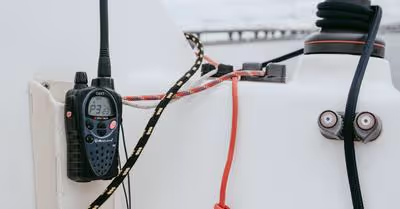Table of Contents
What is Tacking?
Tacking is a maneuver in which the boat is turned through the wind so that the wind blows from one side of the boat to the other. It's called tacking because the boat TACKS back and forth, zig-zagging across the wind. In order to tack, you need to be able to control the sails and the rudder. The sails need to be trimmed so that they are luffing, which means they are flapping in the wind. The rudder is used to turn the stern of the boat into the wind. As the stern swings around, the bow will come through the wind and begin heading in the opposite direction. This maneuver allows the vessel to take advantage of the wind while still making progress in the desired direction.
Tacking can be used in both small boats and large ships, and it is a skill that every sailor should master. While tacking may seem like a simple maneuver, it can actually be quite difficult to execute properly. In order to tack successfully, sailors must have a good understanding of the wind and how their boat behaves in different conditions.
This maneuver is essential for sailing; without it, you would be unable to change direction or make progress against the wind. With practice, however, tacking can become second nature, and it is an essential skill for anyone who wants to explore the world by boat.
How To Tack a Sailboat
There are two main types of tacks: forehand and backhand. A forehand tack is when you turn the bow (front) of the boat toward the wind, while a backhand tack is when you turn the stern (back) of the boat toward the wind.
Forehand Tack
A forehand tack is when the boat is turned onto a close reach by turning the bow through the wind. The term "forehand" refers to the fact that the wind is blowing on the front of the sails, and "tack" refers to turning the boat. This maneuver is often used when sailing upwind, as it allows the boat to sail closer to the wind.
In order to execute a forehand tack, the helmsman must first turn the wheel hard over to leeward, then ease the mainsheet and traveler. The sails will then luff, and the bow will swing through the wind. Finally, the helmsman must trim the sails and sheets before resuming the course. Although a forehand tack may take some practice to master, it is an essential skill for any sailor who wants to sail upwind efficiently.
Backhand Tack
A backhand tack is a sailing maneuver in which the wind hits the back of the sailboat as it tacks, or turns, into the wind. This can be tricky to execute because it requires the sails to be trimmed correctly and the helmsman to have a good sense of timing. But, when done correctly, a backhand tack can help a sailboat maintain its speed and keep its crew safe from getting hit by the boom. The backhand tack is also useful for avoiding obstacles and other boats, and it can also be used to change direction when sailing downwind. It can be executed quickly and smoothly with practice, making it an essential skill for any sailor.
So, how do you execute a backhand tack? First, you'll need to determine when the wind is blowing from behind your boat. Then, you'll need to raise the mainsail and jib while turning the rudder into the wind. Once the sails are trimmed correctly, you can release the sheets and let the wind fill them. Finally, turn the helm hard over to finish the tack. With practice, you'll be able to execute a backhand tack like a pro!
How To Improve Your Tacks
There are a few things you can do to improve your tacks.
Practice In Light Wind
Many sailors find that one of the best ways to improve their tacking is to practice in light wind conditions. In stronger winds, it can be difficult to keep the boat moving in a straight line, and sails can whip dangerously. However, in lighter winds, it's easier to maintain control and get a feel for how the boat responds to different movements. Practicing in light wind allows you to get a feel for how your boat behaves and how the sails need to be trimmed.
As a result, sailors who spend time practicing in light winds often find that they tack with greater precision and confidence when the wind picks up. Of course, it's also important to practice in a variety of conditions so that you're prepared for whatever Mother Nature throws your way. But if you're looking to hone your tacking skills, then spending some time sailing in light winds is a great place to start.
Crew Positioning
While it may seem like the most important factor in tacking is the wind, the positioning of your crew can also have a big impact on how well you tack. If your crew is too far forward, they will be unable to put enough weight on the windward side of the boat, and it will be difficult to tack. On the other hand, if your crew is too far back, they will not be able to keep the boat balanced, and it will be difficult to maintain control.
For example, if you have a strong wind from behind, you'll want to put your heaviest crew member near the back of the boat. This will help keep the boat's nose down and prevent it from turning too quickly. Similarly, if you're sailing with a strong crosswind, you'll want to put your heaviest crew member on the windward side of the boat. This will help to keep the boat balanced and prevent it from capsizing. With a little careful planning, you can use your crew's weight and position to your advantage and make tacking easier and more efficient.
Additionally, all crew members should be aware of where they need to be during a tack and should move quickly and efficiently to their positions. By having a well-organized crew, you can make sure that everyone is in the right place at the right time, which will make tacking smoother and simpler.
Start With Short Tacks
When you're first learning how to tack, it's best to start with short tacks. This will help you get a feel for how the boat moves and how the sails need to be trimmed. Once you've mastered short tacks, you can start working on longer ones.
Additionally, when you're first learning how to tack, it's important to go slowly and be mindful of each movement. As you become more comfortable with the process, you can start to move more quickly. However, it's still important to be careful and take your time until you're confident that you can execute a tack smoothly and efficiently.
Once you've mastered short tacks, you can start working on longer ones. The key to successful tacking is to keep the boat moving in a steady rhythm. This means that you need to be able to control the speed of the boat and make small adjustments to the sails as you go. It takes some practice to get the timing right, but once you've got it down, you'll be able to tack effortlessly.
Trim Out of The Tack
As you tack, it's important to trim your sails to draw as much wind as possible. This will help to keep the boat moving forward and make tacking easier. To do this, you'll need to adjust the position of the sails and the sheets.
On the way into the tack, you'll want to ease out on the sheets. This will allow the sails to fill with wind and give you more power. As you come out of the tack, you'll want to pull in on the sheets. This will help to keep the sails from flapping and provide more control.
By trimming your sails correctly, you can make sure that your boat has enough power to make it through a tack without losing speed or control.
Practice the Release
One of the most important aspects of tacking is the release. This is the moment when you let go of the old tack and switch to the new one. You'll know it's time to release when the boat starts to come around onto the new tack. At this point, you need to quickly let go of the old tack and move onto the new one. If you wait too long, you won't be able to make a successful tack, and your boat will end up going off course.
This is important for two reasons. First, it ensures that you're not carrying any excess weight into the new tack. Second, it allows you to start fresh with a new tack that is hopefully better suited to the current conditions. To release the old tack, simply undo the clips or Velcro that are holding it in place. Then, take a few deep breaths and let go. If all goes well, you'll be able to quickly switch to the new tack and continue on your way. However, if you're not careful, you may find yourself floundering without a proper tack.
Therefore, it's important to be mindful of the release and make sure that you're doing it at the right time. With a little practice, you'll be able to master the release and make tacking easier and more efficient.
Tacking Terminologies
There are a few key terms that you should be familiar with before you start tacking. These terms will help you understand the process and ensure that you're doing it correctly.
Ready About
"Ready About" is a term that you'll often hear when sailing. It's used to indicate that the boat is ready to tack. This means that the crew is in their positions, and the sails are trimmed correctly. Once you hear this command, you need to quickly release the old tack and move onto the new one.
Lee Helm
The "lee helm" is the side of the boat that is furthest away from the wind. This is the side that you'll be tacking towards. When you're tacking, you need to make sure that the lee helm is clear. This means that there's no one in the way and that the sails are trimmed correctly. If everything is clear, you can proceed with the tack.
Clew first
"Clew first" is a term used to indicate which way the sails should be trimmed when tacking. When trimming the sails, you need to make sure that the clew (the corner of the sail) goes over first. This will help to ensure that the sails are trimmed correctly and that the boat is balanced.
Jib Sheets
When you're trimming the jib sheets, you need to make sure that they're tight enough to keep the sails in place but not so tight that they're pulling the sails in the wrong direction. You'll also need to adjust them as you tack, making sure that the sails are aligned correctly.
Hard-A-Lee
"Hard-A-Lee" is a term used to indicate that the boat is turning. This happens when the sails are trimmed correctly, and the wind catches them. The boat will start to turn, and you need to be ready to release the old tack and move onto the new one.
Lee-Ho
The helmsman shouts "Lee-Ho" when the boat is on the new tack, and they're ready to start sailing again. This is your cue to start trimming the sails and getting the boat back under control.
Recent Articles

















